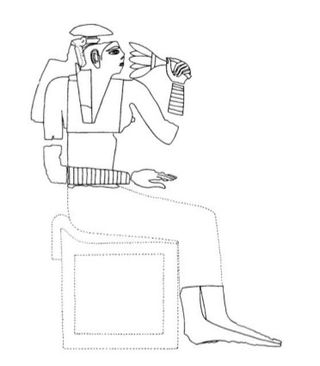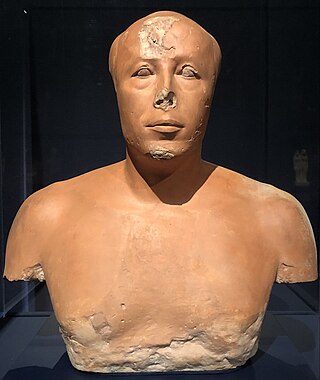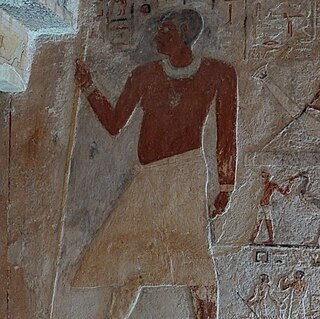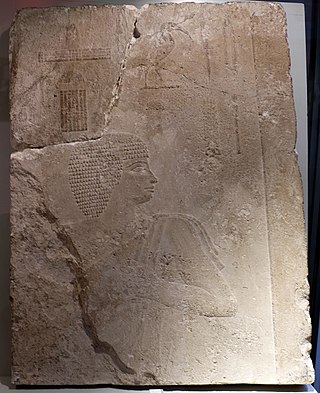
Khafre or Khafra, also known as Khephren or Chephren, was an ancient Egyptian pharaoh of the Fourth Dynasty during the Old Kingdom. He was the son of Khufu and the successor of Djedefre.

Hetepheres II was a Queen of Ancient Egypt during the 4th Dynasty.

Hetepheres I was a queen of Egypt during the Fourth Dynasty of Egypt who was a wife of one king, the mother of the next king, the grandmother of two more kings, and the figure who tied together two dynasties.

Ankhhaf was an Egyptian prince and served as an overseer during the reign of the Pharaoh Khufu, who is thought to have been Ankhhaf's half-brother. One of Ankhaf's titles is also as a vizier, but it is unknown which pharaoh he would have held this title under. He lived during Egypt's 4th Dynasty.

Queen Meresankh III was the daughter of Hetepheres II and Prince Kawab and a granddaughter of the Egyptian pharaoh Khufu. She was the wife of King Khafre.
Nebemakhet was a king's son and a vizier during the 4th Dynasty. Nebemakhet was the son of King Khafre and Queen Meresankh III. He is shown in his mother's tomb and in his own tomb at Giza.
Meritites I was an ancient Egyptian queen of the 4th Dynasty. Her name means "Beloved of her Father". Several of her titles are known from a stela found at Giza. She was buried in the middle Queen’s Pyramid in Giza.

Kawab is the name of an ancient Egyptian prince of the 4th Dynasty. He was the eldest son of King Khufu and Queen Meritites I. Kawab served as vizier and was buried in the double mastaba G 7110–7120 in the east field which is part of the Giza Necropolis.
Kaemsekhem was an ancient Egyptian nobleman and probably the son of Crown Prince Kawab and Hetepheres II. He later served as the director of the royal palace. He was buried in mastaba G 7660 in the Giza East Field, which is part of the Giza Necropolis.

Meresankh II was a Queen of Egypt who lived during 4th Dynasty.

Khentkaus I, also referred to as Khentkawes, was a royal woman who lived in ancient Egypt during both the Fourth Dynasty and the Fifth Dynasty. She may have been a daughter of king Menkaure, the wife of both king Shepseskaf and king Userkaf, the mother of king Sahure. Some suggest that she was the regent for one of her sons. Perhaps, in her own right, she may have been the king of Upper and Lower Egypt, which aspects of her burial suggest. Her mastaba at Giza – tomb LG100 – is located very close to Menkaure's pyramid complex. This close connection may point to a family relationship. Although the relationship is not clear, the proximity of the pyramid complex of Khentkaus to that of king Menkaure has led to the conjecture that she may have been his daughter.
Princess Hetepheres was an Egyptian princess who lived during the 4th Dynasty. Hetepheres was the daughter of King Sneferu and the wife of vizier Ankhhaf.
Duaenre was a vizier under Menkaure during the Fourth Dynasty of Egypt. His titles include those of king's son of his body, hereditary prince, count, vizier (tAjtj), scribe of the divine book, mouth of Nekhen, and mouth of every Butite.
Nebty-tepites was a Princess of ancient Egypt. She is mentioned in the tomb of her mother, Meresankh II.
Iunmin was a vizier from the Fourth Dynasty of Egypt. He was possibly a son of king Khafre. He served as vizier towards the end of the dynasty, possibly during the reign of his brother Menkaure.

Meritites II or Meritites A was a 4th Dynasty princess of ancient Egypt, probably a daughter of King Khufu. She may have been a daughter of Meritites I based on the fact that this queen is mentioned in mastaba G 7650. She married the Director of the Palace, Akhethotep, and she had several children with her husband. Meritites and her husband shared a mastaba G 7650 in Giza.
Iunre (Yunre) was an ancient Egyptian prince of the 4th Dynasty. He was the son of king Khafre. He was named after Ra.
Ankhmare was an ancient Egyptian prince and vizier of the 4th Dynasty. His titles include king's eldest son of his body, as well as chief justice and vizier. Ankhmare was a son of Pharaoh Khafre and was named after the god Ra.
Rekhetre was an ancient Egyptian queen from the late 4th Dynasty or early 5th Dynasty. She was a daughter of Pharaoh Khafre. Her husband is never mentioned, but Rekhetre would have been the wife of one of Khafre's successors, possibly Menkaure.
Nefertkau III was an ancient Egyptian princess. She lived during the 4th Dynasty. She was possibly a daughter of Meresankh II and Horbaef. If so, she was a granddaughter of King Khufu. Baud has proposed that Nefertkau was a daughter of Khufu instead. Nefertkau has the titles King's daughter of his body and Priestess of Neith in a scene in the chapel of her tomb. She was married to an official named Iynefer. Nefertkau and Iynefer had a daughter also called Nefertkau and two or three sons. Strudwick has suggested that Iynefer may be a son of Khufu. Depending on the interpretation of the family relationships Nefertkau may have married either her uncle or her brother.








